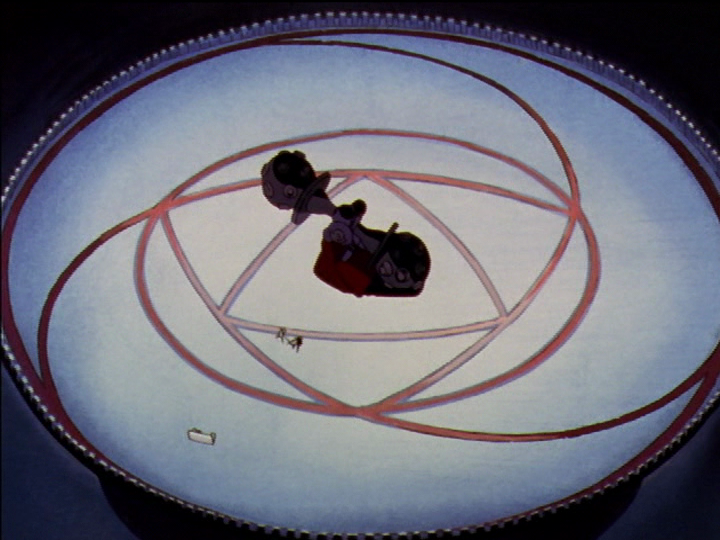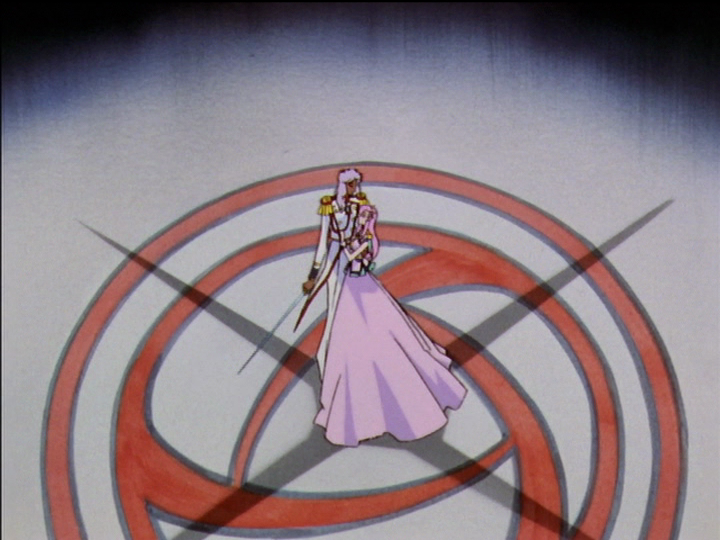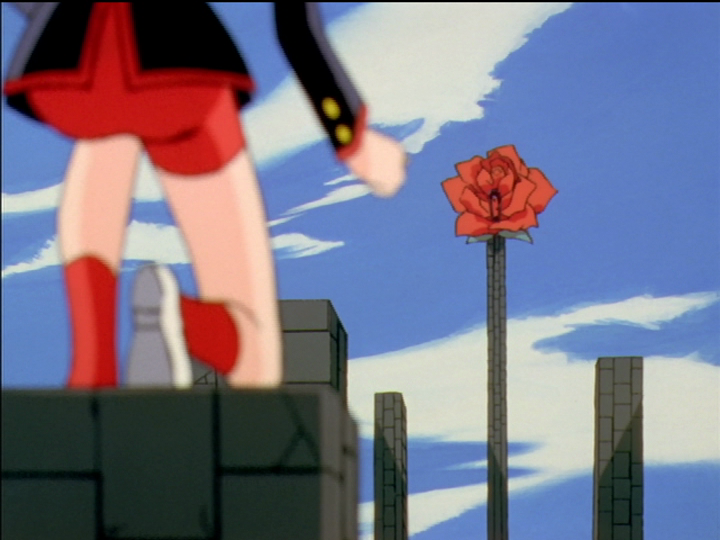Utena - Nadia: The Secret of Blue Water
My evaluation: Nadia is inconsistent in quality. Most episodes are good. Some, especially in the middle, are dull and distract from the flow.

The 1991 series (Anime News Network encyclopedia) was re-released not long ago as I write. It seems that it is often considered a flawed classic. I happened to notice that the title character Nadia has dark skin, dark purple hair, and green eyes like Anthy. (Blue-green eyes, actually, not quite like Anthy’s.) Is it a coincidence, is it influence, or is it a meaningful reference? I watched the series to find out, and found deep connections. I conclude that Nadia has parallels with both Anthy and Utena. Anthy and Utena are aspects of the same thing, and Nadia is a part of both of them.
The Japanese title is fushigi no umi no nadia. Compare the Japanese title of Alice in Wonderland: It is fushigi no kuni no arisu, Alice of the land of wonders. Nadia’s title can be glossed as Nadia of the sea of wonders.
The main characters are Nadia and inventor Jean. Nadia has a lion cub (who doesn’t seem much like Chu-Chu, but there may be a relation). It’s an adventure tale set in 1889 with many deliberately anachronistic inventions. There are extensive borrowings from Jules Verne’s 20,000 Leagues under the Sea, and Captain Nemo and the Nautilus are central. Nemo has somewhat dark skin, green eyes, and slightly purple-shaded hair, which naturally turn out later to be significant (episode 22).
The bad guys are Neo Atlantis, descendents of the destroyed ancient Atlantis civilization founded by space aliens. They wear masks but they are indistinguishable from human (and we eventually learn why). Their star currently has a planetary nebula around it; I can see why they had to leave. Neo Atlantis wants to revive Atlantis with the ancient alien superscience, and take over the Earth for their convenience. Though she didn’t know it, Nadia turns out to be a princess of Neo Atlantis, another tie to Utena.
The show can be read as a call for acceptance of other cultures, regardless of their level of knowledge—no war and no exploitation. It contrasts Atlantean superscience, 19th century technology, 20th century technology as invented by Jean, and the simpler tech of 19th century Africa. The depiction of one 19th century African culture is probably intended to be respectful, though it doesn’t entirely come off that way to this 21st century American. At the time the story is set, though it’s not mentioned in Nadia, Europeans were colonizing Africa; they saw Africans as inferior and set about bringing them under control to exploit for European benefit. That’s what Neo Atlantis wants to do to Earth. Nadia is compassionate and principled and ignorant, like Utena, and she is a Neo Atlantean who pushes back, as Utena at Ohtori Academy pushes back against Akio. Unlike Utena, Nadia has firm allies.
Nadia has similarities to Utena. Nadia does not know her parents or origin; Utena is an orphan. Both feel compassion for the mistreated. Both are physically adept (Nadia is a circus acrobat; Utena plays sports). Both can be naive and unrealistic in dealing with the real world, and slow to understand their own feelings. Both jump to conclusions but improve over time. Both live by strict principles. Nadia rants at those who do not live up to her strict vegetarianism and no killing, even when they just took action to save her life. It reminds me of Utena’s vehemence. Nadia’s Blue Water jewel (visible in the picture above) corresponds to Utena’s dueling ring.
Jean has similarities to Utena. Like Utena, he is confident and cheerful (though his cheer seems to be natural, rather than a coping mechanism like Utena’s). He loves Nadia, and continues to after realizing she is a difficult person. He rescues Nadia. He creates inventions far ahead of his time—he effectively has his own power of miracles to match Utena’s.
Nadia has similarities to Anthy. Nadia is a talented circus performer. Anthy is also talented. Nadia has low self-confidence. She is maltreated by her boss and expects the same from others. She is discriminated against. Her poor self-confidence and distrust of others mark an earlier and less severe stage of developing the learned helplessness that Anthy suffers. It manifests as prejudice: Nadia says “People are like that,” or later on “Adults are like that.” Anthy is surprised when Utena, and later Miki, treat her kindly. Nadia hides her feelings behind Utena-like outbursts; Anthy hides her feelings behind a blank expression. Anthy and Utena are opposite in most traits, so where Nadia is like Utena, as in compassion and naivety, she is opposite to Anthy.
Nadia is a space alien, though we can’t tell by her appearance or behavior. In episode 14, Kanae says that Anthy is like an alien. The alien superscience corresponds to Utena’s magic, which Akio attributes to Anthy when he calls her a witch.
Nadia wears triple rings around her neck and wrists. They might be related to Anthy’s arm and ankle rings. They look similar, but I don’t see the connection. Her hoop earrings are similar to the earrings worn by Akio and Chu-Chu, but larger. In episode 32, while they are in Africa, we see matching rings worn by African characters. Nobody comments on it. The rings are presumably a clue to her origin. Nadia has always assumed that she was born in Africa, and though it’s a huge continent she wound up by chance in the same cultural zone. In reality, the place was near a gigantic Atlantean vehicle below a lake. Fairyland is underground or underwater—like Atlantis stuff.
Nadia does not believe in taking life. Anthy pretends to the same opinion in episode 6 when she makes a show of not spraying for bugs in the greenhouse, to mislead Nanami.
In episode 4, when in a funk, Nadia speaks to her lion cub as if to Jean. It could be the inspiration for Anthy talking to the kitten as if to Utena in episode 10, when Utena is in a funk.
Betrayal. In Nadia’s final showdown, Neo Atlantis takes away Nadia’s free will, turning her into an automaton, and has her fire a pistol at her allies. It’s a violation of her fundamental principles. It corresponds to Anthy backstabbing Utena. Akio has effectively taken away Anthy’s free will and made her a puppet willing to murder her love.
Adulthood. Episode 17 has an adulthood theme. Jean (age 14) realizes his inexperience and asks for adult help with his inventing instead of trying to do it all himself. It becomes an ongoing motif when Nadia does not realize her immaturity. For Utena’s take, see topic index - adulthood.
Photo wall. In the epilog at the end of the final episode, 39, we see a wall of photos. I could not find any close connection with Mikage’s wall of photos, but both point to past events and they look superficially similar. Maybe it was an inspiration.
Parallel tears. Both are tears in the corner of the eye of one prostrate under the power of evil. They are tears of compassion for another still subject to evil and seemingly unlikely to escape, who nevertheless does escape later: Jean and Anthy. See tear catalog - princess Utena.
It is definitely a meaningful reference. Nadia has been captured by the bad guys, and they explicitly promise to treat her as a princess—she is a princess of Neo Atlantis. That’s why she gets a cushy bed despite being a prisoner. Anthy not only shares aspects of Nadia’s appearance and personality, she is also a captive princess—and the beauty in Sleeping Beauty to go with Nadia’s bed. In the comparison with Utena, Utena is a princess captured by Dios—or rather, by the idea of being like Dios—and then by Akio.
In the same episode, the bad guys try out their superweapon, the “Tower of Babel”, that they plan to use for world domination. (I think it stands for the misunderstanding between cultures due to different languages.) A representative of the bad guys calls it the light of God, and a representative of the good guys calls it demonic light. To me the comparison feels Utena-like. In any case, it continues the parallel. Akio is the bad guy who has captured Anthy, and he also has megalomaniacal plans to rule the world.
Nadia and Nemo stand together. Their shadows dominate the image, and the shadows make sharp turns in the middle. Nemo is telling Nadia that nothing is more important than the Blue Water gem. It reminds me of the stylized shadows in the episode 11 duel when Touga pretends a finishing strike against Utena so that she will call on the prince.
The images look Expressionist, the Nadia image especially. I don’t think it’s a reference, I think it’s shared influence. But both are striking. One literally.
Parallel jewels. A meaningful reference. Click the pictures for larger views. At a funeral in the dead underwater land of Atlantis, Nadia clings to Jean. Jean’s tear falls and lands on Nadia’s Blue Water, activating it. That in turn activates a large ancient Atlantis gem, which puts on a light show, presumably to honor the dead. In Utena, a water drop activates the dueling ring, which in turn activates the machinery to open the dueling forest gate. The tears splash the same way on their gems.
I had already concluded from a comparison in The Rose of Versailles that the dueling forest gate is opened by a tear of grief. This evidence is clearer and means the same.
Aurora. Episode 19 has an aurora over Antarctica with unmistakable similarities to the false aurora over the dueling arena in Utena. It is a reference, and I think it is meaningful. Some stars are picked out as extra-bright, then the aurora appears; it goes with the bright stars that appear in Utena before the castle in the sky fades in and is replaced with the aurora. Nemo explains the science (using words that were only made up in the 20th century), and adds that theory cannot explain its beauty. Nadia realizes—as they stand on the Antarctic ice—that Nemo is not as cold-hearted as he appears.
A second aurora appears in episode 30. I’m not 100% on the meaning, but it seems to indicate hidden superscience machinery working behind the scenes. (Though the Antarctic aurora is explained as natural, Antarctica also has superscience machinery under the ice.) Utena’s aurora poses as a beautiful, romantic natural phenomenon, but is created artificially by machinery behind the scenes. So if I read it right, it shares aspects of both of Nadia’s auroras.
The four diffraction spikes on the bright stars turn them into versions of the four-point eye symbol; see three versus four points below. I’m not sure it’s intended in Nadia; the stars appear over an ancient Atlantean base where Neo Atlantis does not go. Maybe it’s an omen. But in Utena’s aurora, the bright stars have four points, and they make the same X shape as the four pointed shadows in episode 38 (follow the link above). The diffraction spikes mark the stars as belonging to Akio; the planetarium projector is behind them.
Dome. This Atlantean dome, built by space aliens, reminds me of the dome at the base of Akio’s tower. They are similar in size and share color and features. In Utena, the shadow girls claim to be space aliens, but they’re not convincing. Utena’s dome represents the Academy and the system of control. The comparison may mean that Akio’s world, as human as it looks, is unnatural and alien.
The tiny figure is Nadia. The large anthropomorphic object is the plot-convenient vehicle that the group has been traveling in, a submarine-aerostat-tank.
Suicide. After Nadia tells Jean that she is an alien from another star, she wails that she only brings unhappiness, says “sayonara” and steps off the edge of a tall structure. It’s animated in black and white, and may be a reference to something else. One of her tears grazes the Blue Water gem, and it slows her fall so that she is unhurt.
Nadia’s real suicide attempt must be related to Anthy’s false suicide attempt. Nadia and Anthy are strange, or alien, and expect rejection from others. Nadia seems to fear rejection by Jean so much that she yanks her hand out of his to jump. Because of Akio’s manipulation, Anthy believes she has already been rejected by Utena, but Utena moves fast to grab Anthy’s hand and stop her. I think that contrast is the point of the reference.
Eye symbol. Atlantis uses this eye symbol. As a third eye (Wikipedia), it represents special knowledge or insight and the magic-like Atlantean superscience technology. Anthy’s bindi represents a third eye and stands for Anthy’s actual insight and supposed magic. Anthy hides her feelings, metaphorically wearing a mask.
Some of Utena’s rose emblems, especially the rose of the dueling arena, bear a resemblance. The episode 38 image, below and right, shows that the resemblance is intentional. It can represent Akio’s knowledge and power, including the magic-like planetarium projector at the center of the eye.
Three versus four points. The three-point version of the eye symbol is found in ancient Atlantean ruins—not all of which are ruined, some have functional machinery. See the three-point motif; the three points are associated with fairy tales and therefore with Dios. The four-point version is used by evil Neo Atlantis. (The four points are dark and may be hard to see. Click the image for a larger view. Or look at the crowd image immediately above.)
I could not figure out the meaning of the three-point versus four-point shadows in Utena, but here it is. The three points associate Utena with ancient Atlantis, which had both good and evil and was destroyed by internal wars. Ancient Atlantis corresponds to Dios, who both rescued and exploited. The four points say that evil Neo Atlantis corresponds to Akio. Neo Atlantis does not retain all of the ancient Atlantean tech, the same way that Dios was more powerful than Akio is. And the good guys win in the end. It implies that Utena with the power of Dios is ultimately more powerful than Akio, and wins in the end.
The early appearances of the eye symbol go with Anthy, as far as I can tell. These references go with Utena. In the four-point image, Akio and Utena are standing in the middle of a rose emblem which bears a resemblance to the eye symbol.
See comparisons - four points for part of the meaning in Utena. The four point image on the right is prince Utena as Jesus dying on the cross.
Columns. These columns lift from the floor in Nadia’s final showdown. There’s a person on each one, tiny in this picture. They are like the columns that rise from the dueling arena in episode 9, in a scene that foreshadows Utena’s final showdown, and they are used for similar purposes: To raise up important people to show them off (the leader of the bad guys in Nadia; in Utena Anthy in her show coffin as well as Utena) and to isolate others (the good guys are trapped on individual columns that rose from under them; Saionji is left behind on the dueling arena floor). Each belongs to its show’s brand of magic: The Nadia columns are Atlantean superscience tech, the Utena columns are illusions.
I guess the reference is to emphasize that episode 9 foreshadows the final showdown. In Utena, the columns are symbolically male and stand for male control. The columns are part of Touga’s plot, and Akio implements them for Touga.






















